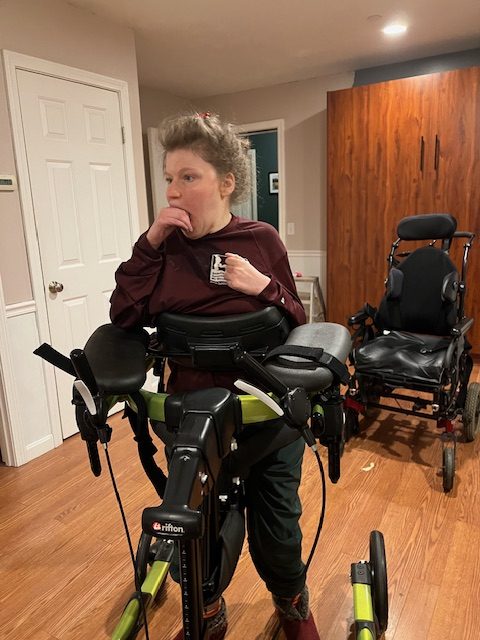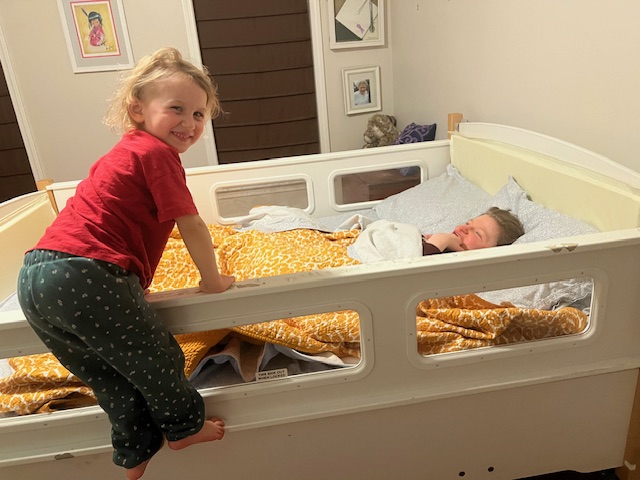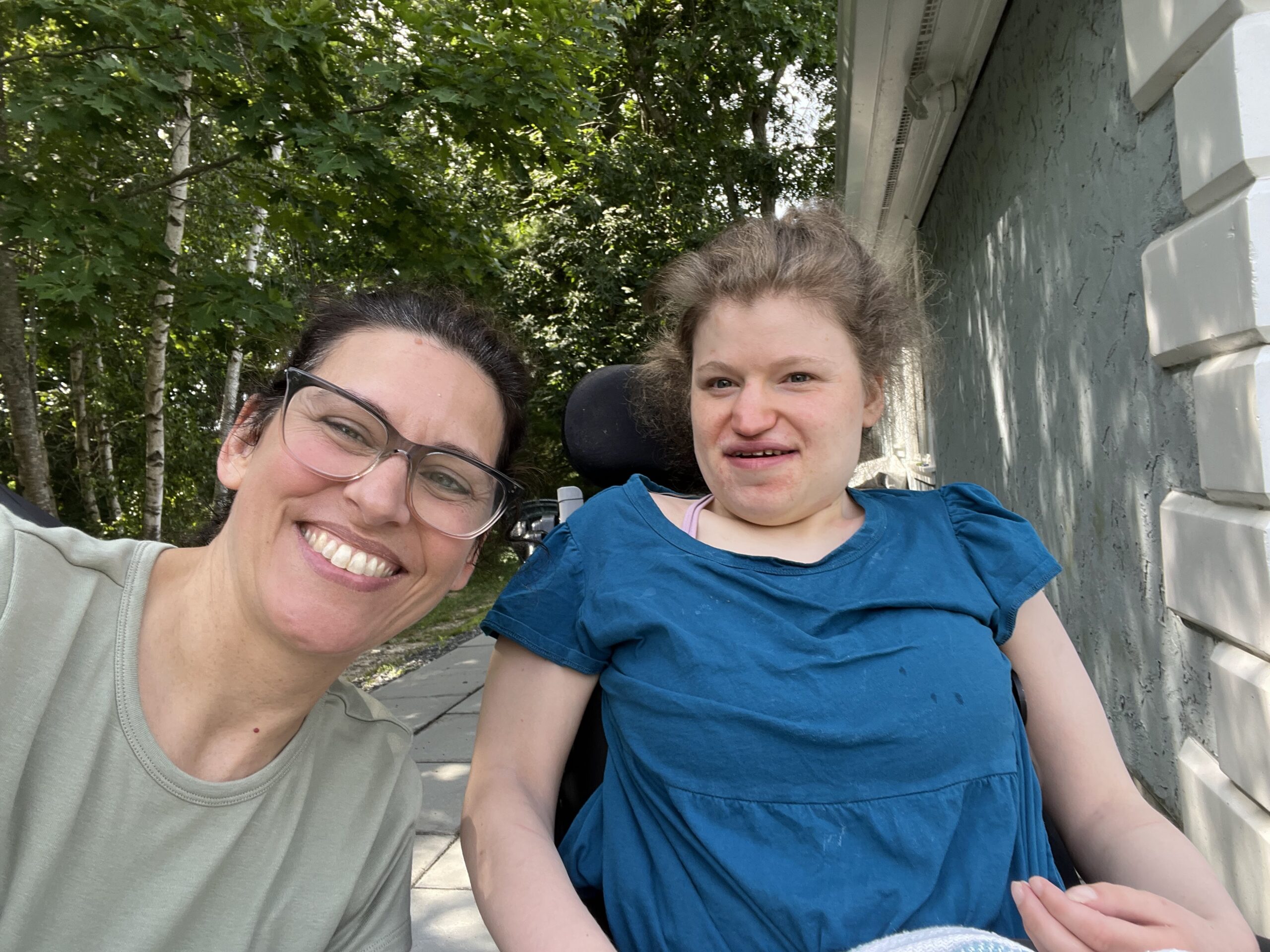Every two years in the month of July the deadline for redetermination of Medicaid coverage looms. My daughter, approaching age 27, has received subsidized health insurance for well over two decades. Her diagnosis, the rare genetic syndrome MPS IIIA (Sanfilippo Syndrome), requires extensive medical surveillance. We are fortunate that its severe impacts, surrounded by developmental delays, seizures and a degeneration of the central nervous system, are greatly but not entirely supported by Medicaid. The trifecta of her syndrome results in not only an all-hands-on-deck approach within the household but, if I’m being forthcoming, also a tremendous financial burden to both the family unit and the taxpayer at large.
 I have long recognized and spoken of the financial burden that my daughter Sasha imposes upon the healthcare system. What I don’t often speak of is the financial impact her condition has on our household. The reality of both parents maintaining employment presents a logistical nightmare, as care management of a medically complex child is a full time job. Authorizations to obtain services are complex, and coordinating referrals, reauthorizations and appointments are commonplace in day to day life making parents both caregiver and case manager.
I have long recognized and spoken of the financial burden that my daughter Sasha imposes upon the healthcare system. What I don’t often speak of is the financial impact her condition has on our household. The reality of both parents maintaining employment presents a logistical nightmare, as care management of a medically complex child is a full time job. Authorizations to obtain services are complex, and coordinating referrals, reauthorizations and appointments are commonplace in day to day life making parents both caregiver and case manager.
In Sasha’s early years, 1:1 supervision was required; she had the physical strength of a child her age but the cognitive awareness of an 18 month old. This made for numerous safety concerns and a need for her to always have eyes on her. Now in her older years the 1:1 supervision has been paramount for hygiene needs, feedings and positioning as she approaches a state nearing paralysis. Training in-home staff in a high turnover field eats up extended time periods and often parents need to fill the gaps in care, making a professional career nearly impossible. I know the continuous financial strain that Sasha’s care has placed on our family all these years, but I am also acutely aware that I am one of the lucky ones. There is sufficient financial stability in our home to provide for the option for me to not work full-time. But I worry – what are other, less fortunate families to do, especially in a political climate of intense governmental financial scrutiny, often by individuals far removed from the real life experiences of families like mine?
 We have also been fortunate with our healthcare system and medical team in the state of New Hampshire. In time we’ve found ourselves an incredible medical team of over 10 specialists that supports both Sasha’s physical health and her mental wellbeing. When we struggled to keep Sasha safe in bed at night due to frequent nocturnal seizures, her neurologist wrote a medical order for a “sleep safe bed”. At that same time, pharmaceuticals were slowly introduced until we found the right mix to halt a most harrowing seizure condition. When her mobility started to wane, multiple consults took place with equipment vendors, doctors and physical therapists to obtain a highly specialized gait trainer- a “walker” to keep her upright for bone health and moving safely through her world. A shower chair to support both her and our safety was introduced.
We have also been fortunate with our healthcare system and medical team in the state of New Hampshire. In time we’ve found ourselves an incredible medical team of over 10 specialists that supports both Sasha’s physical health and her mental wellbeing. When we struggled to keep Sasha safe in bed at night due to frequent nocturnal seizures, her neurologist wrote a medical order for a “sleep safe bed”. At that same time, pharmaceuticals were slowly introduced until we found the right mix to halt a most harrowing seizure condition. When her mobility started to wane, multiple consults took place with equipment vendors, doctors and physical therapists to obtain a highly specialized gait trainer- a “walker” to keep her upright for bone health and moving safely through her world. A shower chair to support both her and our safety was introduced.
Yet, these supports come with a price tag. Let me illustrate just a few. The out-of-pocket cost for the sleep safe bed would have been $10,000. The pharmaceuticals that have remarkably kept Sashsa’s seizures at bay for 12 years would cost $1800 per month without assistance from Medicaid. The out-of-pocket cost for the gait trainer to assist Sasha in safe ambulation would have been over $8,000 and the shower chair we rely on for safe sanitation charged our private insurance over $2,000. Thankfully, these items have all been covered either through our private insurance or Medicaid. While my family situation is secure, I can honestly tell you that bearing the responsibility for these costs without Medicaid, even with private insurance, would break any family including my own.
But this is where so many families like mine sit – in that divide of who benefits and how the financial burden is shared. It is an uncomfortable conversation. I fully see and understand the financial implications that we as society face as we address heaping debt. And yet medical ill fortune could fall on any one of us in an instant.
In nursing school, I had an opportunity to study internationally and perform clinical work with underserved and developmentally impaired communities. This time revealed the sobering truth of why robust medical teams, research and development and social services are so vital here in the United States. The support we have here in the US helps carry us in our day to day lives and it keeps my child living at home, where I want her to be, and where I know her care is less economically burdensome to society at large.
 I have long maintained that, to me, Sasha is truly one IN a million. The physical challenges coupled with the emotional toll of watching her vitality fade NEVER overshadows the joy she brings to my daily life. The lessons she has taught me about love and commitment and gratitude are forever at the forefront of my days. But one could also argue that Sasha is one OF a million. From a financial burden standpoint, if you multiply the above-mentioned costs, you would arrive at a staggering financial total.
I have long maintained that, to me, Sasha is truly one IN a million. The physical challenges coupled with the emotional toll of watching her vitality fade NEVER overshadows the joy she brings to my daily life. The lessons she has taught me about love and commitment and gratitude are forever at the forefront of my days. But one could also argue that Sasha is one OF a million. From a financial burden standpoint, if you multiply the above-mentioned costs, you would arrive at a staggering financial total.
Yet you can not try to tell me there is a price tag you can place on Sasha living to her fullest capacity. There is NO price tag on well-being. Is it costly? YES. But what I also know is that every single child struggling with a rare disease, however complex to navigate, deserves an unbridled full shot. We all do.
I do not know what will happen regarding the bi-annual review of our upcoming Medicaid application. What I do know is that when individuals furthest removed from this reality have the power to make medically impactful legislation, for better or for worse, they may choose to contemplate price tags over human decency and physical health. Officially in the United States, we do not ration health care. But cuts to Medicaid are certainly going to do that. My aim is to not let that happen.
________________________________________________________________________________________________________________
Joanne Huff comes to Courageous Parents Network as a long time follower and parent enthusiast of the organization. As the Mother of two girls, the oldest of whom has the rare disease MPS IIIA/Sanfilippo Syndrome, Joanne has benefited tremendously from the intimate parent interviews and candid, vulnerable story sharing throughout numerous thought provoking blog posts. As her daughter’s activities and lifestyle started to slow down with disease progression, CPN became a larger anchor in times of uncertainty and unrest. It is through this lens that Joanne hopes to share experiences and insights via the CPN blog.
Joanne completed nursing school after her daughter’s diagnosis, receiving her Bachelors of Science in Nursing from Plymouth State University, Plymouth NH. She enjoyed community liaison work with home care providers of adults with special needs up until her own daughter’s care became increasingly more involved. In addition to serving on the Boards of New England Regional Genetics Group (NERGG) and Adaptive Sports Partners through 2024, she has found great purpose in volunteer work advocating for policy improvements and change in Washington DC with the National MPS Society. In her free time, Joanne seeks balance and refuge with yoga, hiking and performing as an ensemble Soprano vocalist with the Pemigewasset Choral Society. When not blogging for CPN, Joanne enjoys sharing offerings on her personal Blog Folding Origami for God. She resides in Bow New Hampshire with her two daughters, Sasha and Nika, her husband Mike and her yellow lab Suki.
